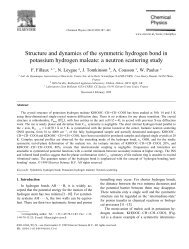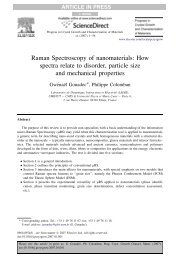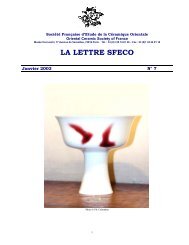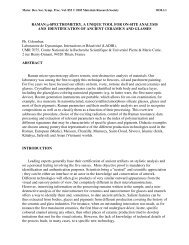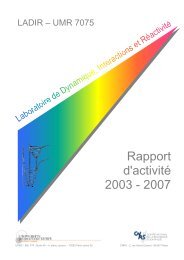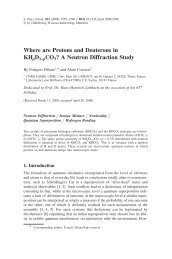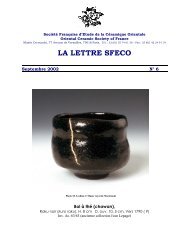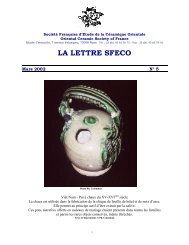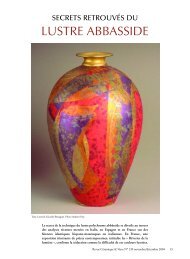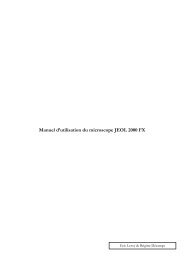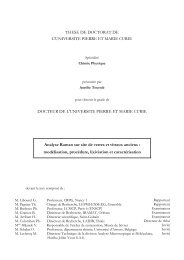12 Nano/microstructure - institut de chimie et des materiaux paris-est
12 Nano/microstructure - institut de chimie et des materiaux paris-est
12 Nano/microstructure - institut de chimie et des materiaux paris-est
- No tags were found...
Create successful ePaper yourself
Turn your PDF publications into a flip-book with our unique Google optimized e-Paper software.
DK4027_book.fm Page 311 Monday, May 16, 2005 2:01 PM<strong>Nano</strong>/<strong>microstructure</strong> and Multiphase Materials 311content) and the sintering temperature. The nanostructure and the porosity (andhence the <strong>de</strong>nsification and many other properties) can therefore be tailored bythe chemical param<strong>et</strong>ers controlling the inorganic polymerization and thehydroxyl content: relative proportion of reagents, additions of complexing liquids,temperature, sonification, sintering atmosphere, and heating rate. 7,25,28,30–33 Theseremarks are general: for instance, the chain length of SiC (or C) polymericprecursor <strong>de</strong>termines the silicon/carbon and carbon/hydrogen stoichiom<strong>et</strong>ry,because terminal branches contain more carbon and hydrogen.Like many hydrates, gels present a unique challenge when <strong>de</strong>nsified un<strong>de</strong>rpressure at room temperature. 34–37 Due to the liquid (water generally) present atthe boundary, viscous rearrangement un<strong>de</strong>r pressure allows <strong>de</strong>nsification andoptimization of the contact b<strong>et</strong>ween polymeric grains, approaching the “perfect”packing obtained by sedimentation: true sintering can be achieved un<strong>de</strong>r thecombined action of the pressure and the liquid phase soaked in the pores (watergenerally, but also alcohol). Gel sintering is associated with an increase in opticalclarity. 36 On heating, the grains formed r<strong>et</strong>ain a memory of the packing of primarymoi<strong>et</strong>ies. The grain growth does not <strong>de</strong>stroy this arrangement. Figure <strong>12</strong>.4b showsgel pell<strong>et</strong>s of Nasicon solid solutions prepared by different sol-gel routes. Translucentor even optically clear samples are easily obtained. The plasticity of thegel offers the possibility of facilitating the compaction of any kind of particle,especially those with an elongated shape (whiskers, platel<strong>et</strong>s), by coating eachparticle with a gel film. 37 The gel coating lubricates the particle and promoteshomogeneity of the applied pressure. Plasticity and shapability disappear withthe loss of the water adsorbed at the “grain” surface, above ~200°C. Dependingon the composition, the shrinkage rate then <strong>de</strong>creases up to 500 (zirconia) to1000°C (aluminosilicates), where drastic shrinkage takes place. The latter resultsfrom the backbone rearrangement due to the <strong>de</strong>parture of the last stabilizing OHgroups (Figure <strong>12</strong>.2 and Figure <strong>12</strong>.3). Note that because of the ability of the gelto be <strong>de</strong>formed, a memory effect very similar to the well-known paste memoryof kaolin-rich porcelain paste can be observed. An example is shown inFigure <strong>12</strong>.5, with a compacted pell<strong>et</strong> of zirconia gel fired at <strong>12</strong>00°C.Gels transform more or less gradually into a meso/microporous glass. 24–26 Alogarithmic plot of the weight loss vs. the inverse of the temperature allows theons<strong>et</strong> <strong>de</strong>termination of water and hydroxyl <strong>de</strong>partures, and hence the measurementFIGURE <strong>12</strong>.5 Self-wrapped zirconia pell<strong>et</strong> after firing at <strong>12</strong>00°C (diam<strong>et</strong>er ~10 mm).



